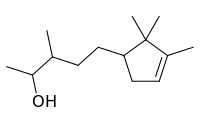Sandalore
Sandalore is a synthetic sandalwood odorant[1][2] with odor in some ways similar to sandalwood and consequently used in perfumes, emollients, and skin cleaning agents. Sandalore, and the similar brahmanol, have been identified as agonists of the cutaneous olfactory receptor OR2AT4, and found to induce strong Ca2+ signals in cultured human keratinocytes. The long-term stimulation of keratinocytes with Sandalore positively affected cell proliferation and migration, and regeneration of keratinocyte monolayers in an in vitro wound scratch assay (i.e., sandalore stimulation also enhanced epidermal "wound healing" in human skin organ cultures). Natural sandalwood oil and other synthetic sandalwood odorants did not have the same effect.
 | |
| Names | |
|---|---|
| Preferred IUPAC name
3-Methyl-5-(2,2,3-trimethylcyclopent-3-en-1-yl)pentan-2-ol | |
| Other names
Sandal pentanol | |
| Identifiers | |
3D model (JSmol) |
|
| ChemSpider | |
| ECHA InfoCard | 100.059.485 |
CompTox Dashboard (EPA) |
|
| |
| |
| Properties | |
| C14H26O | |
| Molar mass | 210.361 g·mol−1 |
Except where otherwise noted, data are given for materials in their standard state (at 25 °C [77 °F], 100 kPa). | |
| Infobox references | |
References
- Daniela Busse, Philipp Kudella, Nana-Maria Grüning, Günter Gisselmann1, Sonja Ständer, Thomas Luger, Frank Jacobsen, Lars Steinsträßer, Ralf Paus, Paraskevi Gkogkolou, Markus Böhm, Hanns Hatt and Heike Benecke (2014). "A Synthetic Sandalwood Odorant Induces Wound-Healing Processes in Human Keratinocytes via the Olfactory Receptor OR2AT4". Journal of Investigative Dermatology. 134 (11): 2823–2832. doi:10.1038/jid.2014.273. PMID 24999593.CS1 maint: multiple names: authors list (link)
- "Skin's ability to 'smell' seems to help it heal itself". New Scientist. 8 July 2014.
This article is issued from Wikipedia. The text is licensed under Creative Commons - Attribution - Sharealike. Additional terms may apply for the media files.